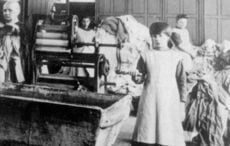Last week, Bronx native Sonia Sotomayor was sworn in as the first Hispanic American member of the Supreme Court.
Amidst all the hoopla, a question arises: Who was the first Irish Catholic Supreme Court judge?
Most people know that Sandra Day O’Connor was the first woman selected to serve on the court. Thurgood Marshall, the first African American, is a well known icon.
The first Italian American is serving on the court right now, Antonin Scalia, the famously cerebral and combative conservative.
Given the attention heaped upon Sotomayor, O’Connor and Marshall (not to mention past Irish Catholic trailblazers such as Al Smith and John F. Kennedy) it’s interesting that the first Irish Catholic on the Supreme Court is more or less forgotten.
Even the first Jewish Supreme Court justice, Louis Brandeis, is fairly well known, since so many schools (including a university in Massachusetts) have been named in his honor.
The man who can be defined as American’s first Irish Catholic Supreme Court justice? Which would essentially make him the first ethnic “minority” to serve on the Supreme Court?
He shares a name with another Irish-American historical figure who is arguably even more famous.
Allow me to explain.
Generally, the first Catholic to do anything in American history is also an Irishman. That’s not the case when it comes to the Supreme Court.
One of the most influential justices, Roger B. Taney, was a Massachusetts Catholic appointed in the 1830s, when churches were regularly burned by anti-Catholic mobs.
As for justices with Irish roots, you can’t get more Irish than William Patterson, named to the court by George Washington in 1793. Patterson was born in Antrim, though he was Scotch Irish, one of many Irish-born Protestants who played a key role in America’s earliest days.
That would make Pierce Butler, appointed to the Supreme Court in 1923 (though the Ku Klux Klan opposed him), the first Irish Catholic to serve on the high court.
Butler’s parents, Patrick and Mary Ann, came to the U.S. from Wicklow. They met in the U.S. and settled in -- of all places -- rural Minnesota.
The Butlers eventually had nine children, though only Pierce and a sister survived into adulthood.
He became a lawyer and a Democrat and was nominated to the high court by President Warren G. Harding.
That’s when the trouble began. Anti-Catholic groups such as the Ku Klux Klan joined forces with progressives to oppose Butler.
At this time, the Klan was an increasingly powerful group, proudly claiming governors and other power brokers as members. They were the nation’s most prominent, even respectable, anti-immigrant/anti-Catholic group.
Butler was ultimately confirmed, however, thanks to lobbying by some of America’s most prominent Catholics.
Butler’s liberal critics were right. Though a Democrat, Butler became Franklin D. Roosevelt’s enemy when the Great Depression struck in the 1930s. As President Obama is today, FDR proposed using public money to spur the economy.
Butler saw this as government meddling in the free market and voted against key FDR proposals. Butler also voted to deny citizenship to a Hungarian immigrant because she was an avowed pacifist.
Butler, however, commendably disagreed with the majority in the 1929 case Buck vs. Bell, which declared that it was constitutional for authorities to forcibly sterilize women deemed to be giving birth to mentally inferior children.
Butler died in 1939 and was replaced by another child of Irish immigrants, former Michigan governor Frank Murphy.
Like him or not, one thing we know about Pierce Butler? No one really knows who he is anymore.
In fact, another Irish-born statesman, also named Pierce Butler, helped fight the American Revolution, shape the U.S. Constitution and later served as South Carolina governor. He may be better known than the Supreme Court justice.
There’s another thing worth noting, given some of the rancor stirred up by Sonia Sotomayor’s nomination. Some believe her status as a “minority” means she will serve as some kind of radical.
Pierce Butler’s career shows us that may not be the case.




Comments